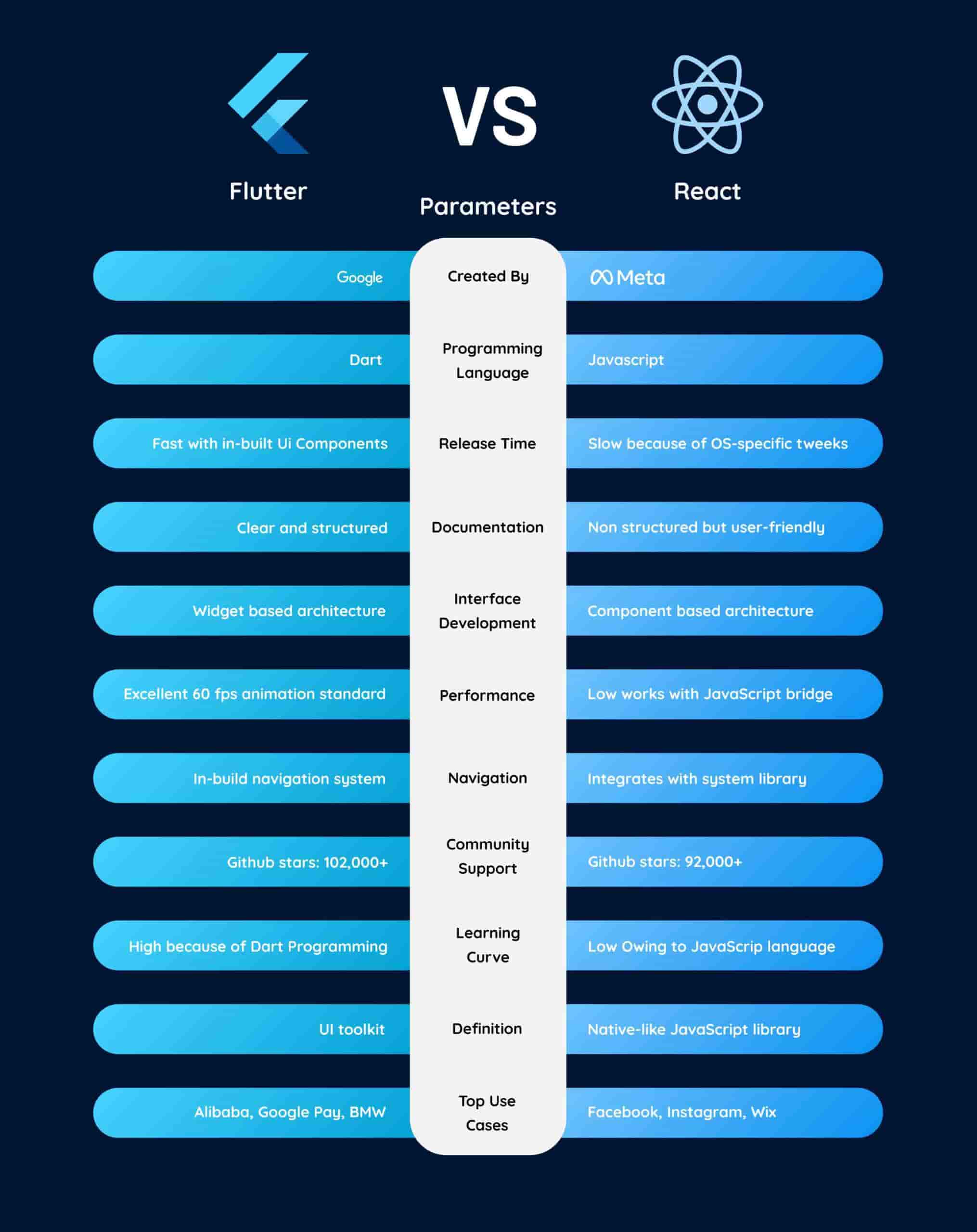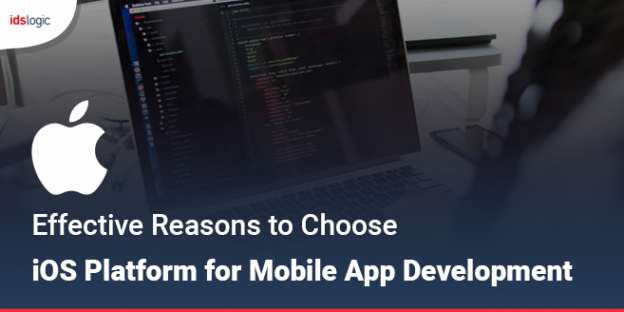Not sure which cross-platform mobile app development framework will work for you in 2024? Keep on reading to know more.
Cross-platform mobile app development frameworks are available in an increased number. The availability of choices in such a vast number is the reason that makes choosing the right mobile app framework difficult. Talking particularly about Flutter Vs React Native, the choice should be made depending on specific requirements.
The blog is going to discuss in detail about Flutter and React Native. We will try to make the selection easier for you by listing all the pointers of both frameworks.
Flutter vs. React Native: An Insight
The market size for cross-platform will reach $546.7 billion by 2033. Talking specifically about Flutter vs. React Native, both frameworks are expected to grow in popularity among companies looking for cross-platform mobile app development frameworks.
Choosing any platform between Flutter Vs. React seems tough owing to the benefits they offer. The Flutter Vs. React war is intense as both frameworks have great functions to offer. However, choosing anyone will seem easier when you have the knowledge about both of them. We will be defining both frameworks one by one to help you make an informed decision.
The framework you choose plays a crucial role in influencing various aspects of your application, including performance, scalability, maintenance, cost, and the speed of development and deployment. Selecting the right mobile app framework can optimise processes, guarantees a seamless user experience, and minimise overall expenses in the long run.
Conversely, making a poor choice can lead to various development challenges. Therefore, to help you save time, effort and a lot of confusion, let’s together explore the ins and outs of both frameworks for making an informed decision.
Flutter framework: origin architect
Flutter has been written using Dart programming language. As a result, it doesn’t depend upon JavaScript to interact with Native components. Dart, in comparison with other popular languages is easy to learn and has traits similar to Swift and Kotlin. Flutter was created by Google and thus got popularity in no time.
Both cross-platform frameworks for app development differ in their system architect. Flutter uses Skia its own rendering engine. Skia provides low-level APIs used for rendering, text layout and other functions as well.
Flutter has been designed to control every single pixel that users draw on the screen. Flutter is renowned for offering a set of rich UI components known as widgets that match the native user interface. Dart offers a native coding experience that is fast and runs smoothly across devices.
React framework: origin architect
In comparison to Flutter, React uses native Android and iOS UI controls to draw content on the screen. React Native realm can easily interact with native platform controls
As a developer, you create shared logic and UI code within the JavaScript domain, facilitating communication between the two realms through the JavaScript bridge. This open architecture offers great flexibility, enabling the targeting of multiple platforms beyond Android and iOS.
However, in applications requiring frequent UI updates, such as those involving animations, the JavaScript bridge can become a performance bottleneck
In practical terms, this makes Flutter more suitable between Flutter Vs. React Native war for constructing UI-intensive applications that demand smooth animations.
 UI rendering
UI rendering
Both Flutter and React Native apps have a native look and feel. But they have diverse ways of appearing native. Flutter apps have widgets while React Native applications use components of Android and iOS to offer the native look and feel.
-
Flutter widgets
Flutter widgets replicate UI components found in Android and iOS. These widgets are developed following the Material Design guidelines on Android and Cupertino design patterns on iOS. As a result, Flutter apps offer the native look and feel without added development efforts.
Flutter offers the freedom to customise existing widgets to suit any preference that users want in high-performance apps. It helps to create apps with user-specific designs.
-
React Native components
React Native uses components already available in Android and iOS. Mobile app developers can directly use these components in their Java code to further customise applications.
Despite numerous differences between Flutter and React Native, both frameworks employ a declarative programming style for constructing user interfaces.
Community support
-
Flutter
Flutter enjoys support from a smaller community as compared to React Native. However, it is increasing in size and growing continually. Flutter packages are catalogued on pub.dev, which serves as the Dart equivalent of NPM.
-
React Native
React Native boasts a longer presence in the development scene and currently boasts a larger community compared to Flutter. The majority of typical challenges encountered in React Native app development have already found solutions on platforms like StackOverflow. Given its integration into the JavaScript ecosystem, assistance is easily accessible for React Native developers.
Given the excellent documentation and supportive communities of both ecosystems, you’ll find ample guidance and assistance when starting with either framework, ensuring you won’t feel lost in your development journey
App development support
-
Flutter
Flutter has well-designed animations to ensure cross-platform mobile app development. It also facilitates the easy implementation of complex animations. When developing large applications, it becomes important to include robust state management solutions. Well-known state management packages like Redux, MobX, and Hooks are accessible for both Flutter and React Native.
-
React Native
React Native comes remarkably close to providing a top-notch native user experience. However, in practical scenarios, performance issues can arise due to the JavaScript bridge, particularly in applications demanding extensive animations or frequent UI updates, unlike Flutter that can easily simplify the development of complex applications.
Testing
-
Flutter
Flutter is extraordinary when it comes to testing. There is widget testing when it comes to testing the UI. The test runs really fast providing an option to support integration test as well. With this facility, it gets easier to test the entire suite with the official Flutter tools.
-
React Native
React Native on the other hand, lacks the official support that Flutter enjoys as a cross-platform mobile app development platform. Therefore, for testing, React needs support from third-party tools to ensure error-free testing.
For both app development frameworks, writing test is important when it comes to building robust applications. Both these cross-platform mobile app development frameworks have strong capabilities to write unit tests.
Web Support
-
Flutter web
Flutter’s initial support was in beta but it faced serious challenges on this platform. When developing the Flutter application, Dart code undergoes compilation into HTML, CSS, and JavaScript to enable browser execution. However, the resultant app size often surpasses that of a typical web app. Additionally, Flutter also encounters scrolling performance issues. In order to resolve the issue, the Flutter team uses Web Assembly (WASM).
-
React Native for the web
React Native is inspired by React in different aspects. React Native developers have the option to use React Native for the web in order to port their web applications to the web by sharing the same codebase.
This is an impressive offering as a similar business logic can easily be shared across major platforms (including iOS, Android and web). While Web apps generally lack functions when compared to native SDKs. However, React Native for the web is an excellent option for many to start.
Flutter Vs. React Native mobile app framework: Pros and cons at a glance
Now that we have a detailed Flutter Vs. React Native comparison, here is the list of pros and cons for both cross-platform mobile app development frameworks.
Pros of Flutter
-
Impressive UI
Flutter provides the option for building high-quality applications based on iOS and Android from a single codebase.
-
Look and feel
Flutter apps can easily adopt the behaviour of specific platforms in order to provide a great look and feel.
-
Time to market
For developers, Flutter provides a better experience when it comes to developing applications. The Flutter future looks promising also and therefore Flutter apps are faster to market.
-
Documentation
Flutter apps have comprehensive documentation and declarative code. Flutter uses Dart and therefore provides app optimisation capabilities to developers and therefore the framework is liked by every cross-platform app development company.
-
Testing
As an impressive mobile app development framework, Flutter enjoys great testing support. With Flutter applications, the requirement for QA support is reduced tremendously.
-
Animation
A number of developers like to use Flutter owing to its capability of making complex animation easier for developers.
Cons of Flutter
-
Flutter web app size issues
Flutter web applications lack production-ready capability owing to size issues. This majorly impacts the performance.
-
Limitation with third-party libraries
Despite Flutter’s expanding packages of plugins, the cross-platform framework for app development remains relatively new, and the availability of third-party libraries accessible for it is smaller when compared to other frameworks like React Native.
-
Challenging learning curve
The Dart programming language that Flutter uses seems tough when it comes to learning. This can pose a challenge for certain developers, particularly for those who are not already familiar with it.
-
Limited adoption
While the framework has been gaining considerable traction in the development community, Flutter is still in its early stages, and its adoption by large corporations is not as widespread as that of more established frameworks.
Famous applications that use Flutter
- Alibaba: A world-renowned B2B e-commerce platform
- Tencent: One of the largest technology companies in China
- Google Ads: Google’s advertising platform uses Flutter for ad management
- New York Times: The New York Times uses the Flutter app to deliver content
Flutter use cases: When to use Flutter?
Flutter is useful for apps when you want the following functions in your apps:
- High-quality applications that are responsive in nature
- Apps that can be developed from a single codebase
- Applications that require custom UI
- Use Flutter for accommodating animation (if required) in applications
Pros of React
-
Performance
React native mobile app development platform enhances the app performance using native modules. It interacts with iOS and Android components to generate codes of native APIs.
-
Code reusability
90% of React Native code can be reused which is a promising feature for developers as they do not need to start the development from scratch. This largely saves time and effort.
-
Simple UI
React ensures simplified UI and thus helps developers in creating an uncomplicated mobile user interface. Apps developed with React achieve a responsive UI.
-
Modular architecture
Modular architecture ensures the application-building process is adjustable helping developers to create intuitive apps that can be updated easily.
-
Improved scalability
React Native makes applications solid and dependable. This mobile app development framework also ensures that developers in order to apply any updates should first change their state ensuring that only permitted components get updated.
-
Access to libraries
React Native offers a range of pre-developed solutions as well as libraries that are made available for free. Therefore, developers can easily access these libraries free of cost and therefore can easily develop feature-rich bug-free applications.
Cons of React Native
-
Evolving platform
React Native is continually evolving with newer and more improved updates being released every week. Therefore, app developers need to update their apps regularly being in a never-ending app update cycle.
-
Complex UI
For many developers, React Native seems to have complex gestures, meaning developers might struggle with screen transitions and animations.
-
Low security
React native mobile app development framework is open source meaning it keeps on getting security issues. Therefore, apps that need extra security must be taken good care of when they are developed with React Native.
-
Memory management
React Native is not suitable to use for apps that are computation-intensive as it is based on JavaScript. React Native to some extent has a negative impact on the performance and speed of applications. Added to that, there is an inefficient handling of float computations.
Famous applications that use React Native
- Facebook: Globally acknowledge social networking site
- Wix: A platform to offer cloud-based web development services
- Walmart: Operates in retail and wholesale business
- Instagram: Photo and video-sharing social networking site
React Native use cases: When to use React Native?
Use React Native when you want applications that have:
- Simple cross-platform nature and can be developed with a single codebase
- Capability to run over smartphones and on the web
- Simple native components and can run on Android and iOS
- JavaScript and React.js advantages
In Conclusion
Both Flutter and React Native are robust cross-platform mobile app development frameworks used for developing high-performance applications. both the frameworks have a separate user base owing to their specific list of pros.
Having their specific set of features, both frameworks are exceptional for app development requirements. However, when choosing the one, have a look at the requirements of your application to ensure the right selection.










